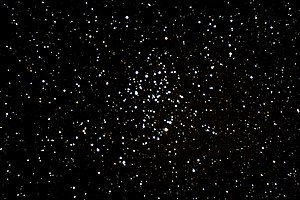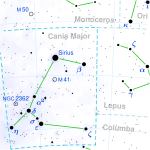| Messier 50 | |
|---|---|
 Open Messier 50 in Monoceros Open Messier 50 in Monoceros | |
| Observation data (J2000 epoch) | |
| Right ascension | 07 02 47.5 |
| Declination | −08° 20′ 16″ |
| Distance | 2,870 ly (881 pc) |
| Apparent magnitude (V) | 5.9 |
| Apparent dimensions (V) | 16.0′ |
| Physical characteristics | |
| Mass | > 285 M☉ M☉ |
| Radius | 8.9 ly (2.73 pc) |
| Estimated age | 140 Myr |
| Other designations | M50, NGC 2323, Cr 124, C 0700-082, OCl 559 |
| Associations | |
| Constellation | Monoceros |
| See also: Open cluster, List of open clusters | |
Messier 50 or M 50, also known as NGC 2323 or the Heart-shaped Cluster, is an open cluster of stars in the constellation Monoceros. It was recorded by G. D. Cassini before 1711 and independently discovered by Charles Messier in 1772 while observing Biela's Comet. It is sometimes described as a 'heart-shaped' figure or a blunt arrowhead.
M50 is about 2,900 light-years away from Earth and is near to but narrowly not estimated to be gravitationally tied to the Canis Major (CMa) OB1 association. It has a core radius of 5.9 ly (1.8 pc) and spans 17.8 ly (5.46 pc). The cluster has 508 confirmed and 109 probable members – their combined mass is more than 285 M☉, the mean stellar density would thus be 1.3 stars per cubic parsec. It is around 140 million years old, with two high-mass white dwarfs and two chemically peculiar stars.
Gallery
-
 Sirius and M41 (lower right), M50 (upper left), and NGC 2360 (lower left)
Sirius and M41 (lower right), M50 (upper left), and NGC 2360 (lower left)
-
 Messier 50 is found 8° north and 3° east of Sirius
Messier 50 is found 8° north and 3° east of Sirius
See also
References and footnotes
- ^ Frolov, V. N.; et al. (February 2012), "Investigation of the open star cluster NGC 2323 (M50) based on the proper motions and photometry of its constituent stars", Astronomy Letters, 38 (2): 74–86, Bibcode:2012AstL...38...74F, doi:10.1134/S106377371202003X, S2CID 255199532.
- ^ Kharchenko, N. V.; et al. (2005), "Astrophysical parameters of Galactic open clusters", Astronomy and Astrophysics, 438 (3): 1163–1173, arXiv:astro-ph/0501674, Bibcode:2005A&A...438.1163K, doi:10.1051/0004-6361:20042523, S2CID 9079873.
- ^ Thompson, Robert; Thompson, Barbara (2007), Illustrated Guide to Astronomical Wonders: From Novice to Master Observer, DIY science, O'Reilly Media, Inc., p. 321, ISBN 978-0596526856
- ^ Claria, J. J.; et al. (February 1998), "Photometric study of the open cluster NGC 2323", Astronomy and Astrophysics Supplement, 128: 131–138, Bibcode:1998A&AS..128..131C, doi:10.1051/aas:1998130
- "M 50". SIMBAD. Centre de données astronomiques de Strasbourg. Retrieved 27 November 2018.
- Sharma, Saurabh; et al. (May 2008), "Mass Functions and Photometric Binaries in Nine Open Clusters", The Astronomical Journal, 135 (5): 1934–1945, arXiv:0803.0122, Bibcode:2008AJ....135.1934S, doi:10.1088/0004-6256/135/5/1934, S2CID 11895493.
- Cummings, Jeffrey D.; et al. (February 2016), "Two Massive White Dwarfs from NGC 2323 and the Initial-Final Mass Relation for Progenitors of 4 to 6.5 M", The Astrophysical Journal, 818 (1): 13, arXiv:1601.03053, Bibcode:2016ApJ...818...84C, doi:10.3847/0004-637X/818/1/84, S2CID 119263067, 84.
- Paunzen, E.; et al. (April 2014), "Photoelectric search for peculiar stars in open clusters. XV. Feinstein 1, NGC 2168, NGC 2323, NGC 2437, NGC 2547, NGC 4103, NGC 6025, NGC 6633, Stock 2, and Trumpler 2", Astronomy & Astrophysics, 564: 8, arXiv:1403.3538, Bibcode:2014A&A...564A..42P, doi:10.1051/0004-6361/201423521, S2CID 119174151, A42.
- Eight out of ninety degrees south of the celestial equator. Thus its light reaches all parts of the Earth, down to a good minimal cumulation 15° above the horizon, on the unobstructed southern horizons of the 67th parallel north. This rules out Iceland and the north coasts of the two northernmost continents.
- On 5 April
External links
- Messier 50 - at Deep Sky Videos
- Messier 50, SEDS Messier pages
- M50 Image by Waid Observatory
- Messier 50 on WikiSky: DSS2, SDSS, GALEX, IRAS, Hydrogen α, X-Ray, Astrophoto, Sky Map, Articles and images
| Messier objects | ||
|---|---|---|
| List |
|  |
| See also | ||
| Constellation of Monoceros | |||||||||||||
|---|---|---|---|---|---|---|---|---|---|---|---|---|---|
| Stars |
| ||||||||||||
| |||||||||||||
| Star clusters |
| ||||||||||||
| Nebulae |
| ||||||||||||
| Galaxies |
| ||||||||||||